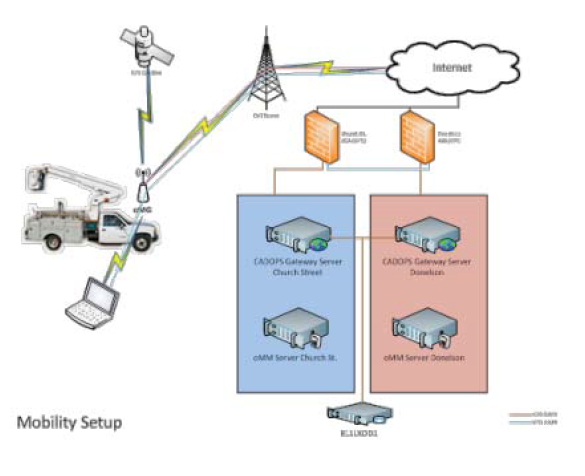Nashville Electric Service
Nashville Electric Service Extend the Enterprise to the Mobile Workforce for Lower Costs, Increased Safety

Nashville Electric Service Extend the Enterprise to the Mobile Workforce for Lower Costs, Increased Safety
Nashville Electric Service (NES) is one of the largest publicly owned electricutilities in the US, serving more than 360,000 residential and businesscustomers across seven counties in north-central Tennessee. In 2010, theAmerican Public PowerAssociation awarded NES the Reliable Public PowerProviders (RP3®) Diamond status, the electric industry’s highest designation forreliability, safety, workforce development and system improvement. Based on a2011 survey, customers ranked NES as “Excellent” or “Good” with a 91% ratingat “maintaining a continuous fl ow of power” and an 85% rating at “restoringservice after storms.”
BUSINESS CHALLENGE
In 2002, NES with local government and police were using an 800 MHz radiosystem with additional channels for data transmissions. NES’ fi rst applicationwith data was an automatic vehicle location (AVL) system that consisted ofa basic modem, router and triple GPS system. Vehicle location data was feddirectly into the outage management system and was monitored on a digitalmap. All other work orders were manually dispatched by looking at the mapand determining the location of the vehicle and outage and making a workassignment through the radio. This system served NES’ purpose for over 6years. However, as the technology became obsolete, they needed to considereither a vehicle-centric AVL solution or onboard computer alternatives.
While considering their current needs, NES also determined their requirements going forward, such as:
In 2008 NES reviewed the alternatives and wrote an RFP. “When we beganour search for a new mobile communications technology, we had set verydemanding specifi cations,” said Vic Hatridge, Nashville Electric Service’s ChiefInformation Officer.
SIERRA WIRELESS INMOTION SOLUTION
Based on NES’ specifi cations, an InMotion Solution was selected asbest able to deliver:
NES installed the oMGs in their bucket trucks and supervisory vehicles,which provided wireless connectivity to laptops and other devices in andaround the vehicle. The oMG roams across wireless networks to providethe highest bandwidth and most reliable communications. The InMotionSolution was straightforward for Operations to install, maintain andupgrade, and requires no fi eld worker intervention.
The oMG is GPS-enabled and simulcasts a GPS location to 4 NESlocations – 2 in the data center and 2 in the data recovery center – sothat data is not funnelled from one server to another, and all serversreceive the information directly. The GPS information allows NESdispatchers to track all vehicles on a single screen and dispatch theclosest truck to an outage or service call – a capability that reducesresponse times and fuel use, while improving effi ciency and customerservice. Additionally, the oMG establishes a secure connection, and inemergency situations can provide Wi-Fi access for other vehicles in theimmediate area.
The oMM web-based management system was installed in the NESdata center and scans and analyzes information from oMGs to provideNES with real-time and historical information about its operations andcommunications. If a vehicle leaves its designated service area orexceeds speed limits, dispatchers receive email alerts. Dispatcherscan now view an outage and the trucks moving in real-time to the area,and can inform customer service about service updates. NES also usesthe oMM to map all available wireless networks in its service area andselects the one with the best coverage.

THE RESULTS: TESTED, TRUSTED AND PROVEN
The InMotion Solution allows Nashville Electric Service to fully extend the enterprise to the mobileworkforce, leverage the power of 4G LTE networks, and provide the robustness they need todayand for the future.
Reduce operating costs
Manage customer interactions in real-time
Improve routing and scheduling
Increase worker productivity and safety
THE FUTURE
Shortly, NES will be implementing a new mobility work management program to all hand-held andvehicle mounted Wi-Fi devices to allow for automated dispatching, map queries, time entry andphoto/video uploads.
CUSTOMER CRITICAL CHALLENGE
SOLUTION
BENEFITS
Nashville Electric Service (NES) is one of the largest publicly owned electricutilities in the US, serving more than 360,000 residential and businesscustomers across seven counties in north-central Tennessee. In 2010, theAmerican Public PowerAssociation awarded NES the Reliable Public PowerProviders (RP3®) Diamond status, the electric industry’s highest designation forreliability, safety, workforce development and system improvement. Based on a2011 survey, customers ranked NES as “Excellent” or “Good” with a 91% ratingat “maintaining a continuous fl ow of power” and an 85% rating at “restoringservice after storms.”
BUSINESS CHALLENGE
In 2002, NES with local government and police were using an 800 MHz radiosystem with additional channels for data transmissions. NES’ fi rst applicationwith data was an automatic vehicle location (AVL) system that consisted ofa basic modem, router and triple GPS system. Vehicle location data was feddirectly into the outage management system and was monitored on a digitalmap. All other work orders were manually dispatched by looking at the mapand determining the location of the vehicle and outage and making a workassignment through the radio. This system served NES’ purpose for over 6years. However, as the technology became obsolete, they needed to considereither a vehicle-centric AVL solution or onboard computer alternatives.
While considering their current needs, NES also determined their requirements going forward, such as:
- increased bandwidth for new applications and on-board systems
- Wi-Fi hotspots to support wireless rugged devices
- ability to use multiple wide area networks for increased coverage
- ability to track location of critical assets in real-time
- reduction in response times to outages
- increased employee safety
- use of an enterprise management system
- ability to expand the system in the future
In 2008 NES reviewed the alternatives and wrote an RFP. “When we beganour search for a new mobile communications technology, we had set verydemanding specifi cations,” said Vic Hatridge, Nashville Electric Service’s ChiefInformation Officer.
SIERRA WIRELESS INMOTION SOLUTION
Based on NES’ specifi cations, an InMotion Solution was selected asbest able to deliver:
- simultaneous downstream and upstream Wi-Fi
- support for multiple wireless wide area networks
- dependable wireless connectivity
- extreme reliability
- a rugged self-contained box, industrial strength cables and antennas
- expansion capabilities for future use by additional applications and technologies.
NES installed the oMGs in their bucket trucks and supervisory vehicles,which provided wireless connectivity to laptops and other devices in andaround the vehicle. The oMG roams across wireless networks to providethe highest bandwidth and most reliable communications. The InMotionSolution was straightforward for Operations to install, maintain andupgrade, and requires no fi eld worker intervention.
The oMG is GPS-enabled and simulcasts a GPS location to 4 NESlocations – 2 in the data center and 2 in the data recovery center – sothat data is not funnelled from one server to another, and all serversreceive the information directly. The GPS information allows NESdispatchers to track all vehicles on a single screen and dispatch theclosest truck to an outage or service call – a capability that reducesresponse times and fuel use, while improving effi ciency and customerservice. Additionally, the oMG establishes a secure connection, and inemergency situations can provide Wi-Fi access for other vehicles in theimmediate area.
The oMM web-based management system was installed in the NESdata center and scans and analyzes information from oMGs to provideNES with real-time and historical information about its operations andcommunications. If a vehicle leaves its designated service area orexceeds speed limits, dispatchers receive email alerts. Dispatcherscan now view an outage and the trucks moving in real-time to the area,and can inform customer service about service updates. NES also usesthe oMM to map all available wireless networks in its service area andselects the one with the best coverage.

THE RESULTS: TESTED, TRUSTED AND PROVEN
The InMotion Solution allows Nashville Electric Service to fully extend the enterprise to the mobileworkforce, leverage the power of 4G LTE networks, and provide the robustness they need todayand for the future.
Reduce operating costs
- Transmits data over any wireless network (e.g. Cellular, Wi-Fi)
- Reduces airtime costs by allowing multiple devices to share a single broadband connection
- Identifi es the location of vehicles and allows recovery if they are stolen
- Lowers fuel costs and increases productivity through more effi cient dispatching of vehicles
Manage customer interactions in real-time
- Increases customer response and satisfaction because crews can enter and access customer information in the fi eld in real-time
Improve routing and scheduling
- Tracks vehicle location so dispatchers can assign the closest vehicle for power restoration work
- Scheduled maintenance can be monitored and adjusted based on outage management software and visual map views
- Dispatch can provide specific directions, if required, to crews based on map views
Increase worker productivity and safety
- Crews can operate more effectively in the fi eld with the ability to securely access enterprise systems
- Dispatchers can have an enhanced view of vehicle locations and cross-check to blockout/ lockout procedures
THE FUTURE
Shortly, NES will be implementing a new mobility work management program to all hand-held andvehicle mounted Wi-Fi devices to allow for automated dispatching, map queries, time entry andphoto/video uploads.
CUSTOMER CRITICAL CHALLENGE
- Automatic vehicle location (AVL) system used obsolete technology.
- Work orders were manually dispatched by determining the location of the vehicle and outage, and making a work assignment using radio.
SOLUTION
- oMGs installed in bucket trucks and supervisory vehicles. oMM webbased management system installed in the data center.
BENEFITS
- Reduced operating costs – transmits data over any wireless network, reduces airtime costs, identifi es the location of vehicles and allows recovery if they are stolen, lowers fuel costs and increases productivitythrough more effi cient dispatching of vehicles.
- Customer interactions managed in real-time – increases customer response and satisfaction.
- Improved routing and scheduling – tracks vehicle location, scheduled maintenance can be monitored and adjusted, dispatch can provide specifi c directions to crews based on map views.
- Increased worker productivity and safety – crews can securely access enterprise systems, dispatchers have an enhanced view of vehicle locations and cross-check to blockout/lockout procedures.













